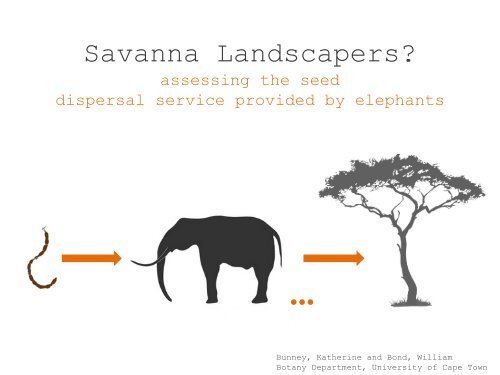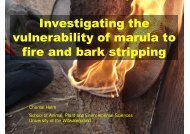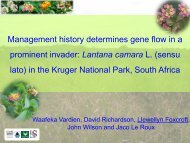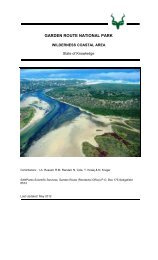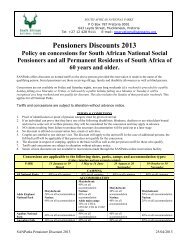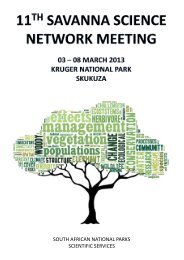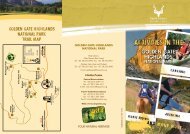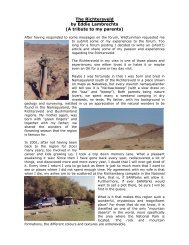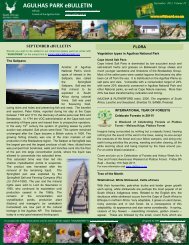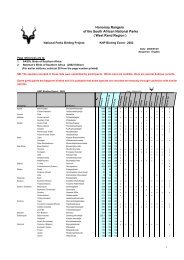Savanna Landscapers? Assessing the seed dispersal ... - SANParks
Savanna Landscapers? Assessing the seed dispersal ... - SANParks
Savanna Landscapers? Assessing the seed dispersal ... - SANParks
Create successful ePaper yourself
Turn your PDF publications into a flip-book with our unique Google optimized e-Paper software.
our questionWhat is <strong>the</strong> spatialscale at which savannaelephants dispersemegafaunal fruit?gut passage + movement dataSteps:1. identify our megafaunal fruit2. get gut passage rate3. analyses movement data4. <strong>dispersal</strong> curve estimation
Identifying South Africa’smegafaunal fruitsUsed Operational definition developed byGuimares et al (2008)South African woody flora (n = 1126) was divided into two types.Type 1) fleshy fruits that are 4–10 cm in diameterwith up to 5 large <strong>seed</strong>s(generally >2.0 cm diameter)Type 2)fleshy/dry fruits that are greater than 10 cmin diameter and have numerous (>) small <strong>seed</strong>s.
Type 1Megafaunal FruitTypeDescription Family Species Seed Mass Consumed byElephantsType Ifruit fleshyfruit maximum length between 4-10cmnumber of <strong>seed</strong>s: 1-5(15)Apocynaceae Carissa macrocarpa not known UArecaceaeRapphia australis,Hyphaene petersiana;Hyphaene coriacea;Borassus aethiopumnot known21500156not knownUYYYBalanitaceaeBalanites aegyptiaca;1150YBalanites maughamii;826.84YBoraginaceae Cordia grandicalyx not known UChrysobalanaceae Parinari curatellifolia 3315 UFlacourtiaceae Rawsonia lucida 81.33 UOchnaceae Ochna glauca not known UPapilionoideae Cordyla africana 10000 YSapotaceaeMimusops zeyheri;291.4UVitellariopsis marginatanot knownUStrychnaceae Strychnos cocculoides 476 UType Ibfruit fleshyfruit maximum length between 3-4cmnumber of <strong>seed</strong>s: 1<strong>seed</strong> mass > 2000(2)EuphorbiaceaeSchinziophyton12500 YrautaneniiAnacardiaceae Sclerocarya birrea 5405 Y17 species
Identifying South Africa’smegafaunal fruitsUsed Operational definition developed byGuimares et al (2008)South African woody flora (n = 1126) was divided into two types.Type 1) fleshy fruits that are 4–10 cm in diameterwith up to 5 large <strong>seed</strong>s(generally >2.0 cm diameter)Type 2)fleshy/dry fruits that are greater than 10 cmin diameter and have numerous small <strong>seed</strong>s.
Type 2Megafaunal FruitTypeDescription Family Species Consumed byElephantsType IIfruit maximumlength > 10cmnumber of <strong>seed</strong>s:numerousfruit fleshy(6)Rubiaceae Gardenia volkensii YStrychnaceae Strychnos spinosa; StrychnospungensUUBombacaceae Adansonia digitata YBignoniaceae Kigelia africana ICapparaceae Cladostemon kirkii Ufruit dryMimosoideaeFaidherbia albida;Y(8)Albizia brevifolia;UAcacia erioloba;YAcacia nilotica;YAcacia haematoxylonUCaesalpinoideaePiliostigma thonningii;YTamarindus indicaYPapilionoideae Swartzia madagascariensis U14 species
our questionWhat is <strong>the</strong> spatialscale at which savannaelephants dispersemegafaunal fruit?gut passage + movement dataSteps:1. identify our megafaunal fruit2. get gut passage rate3. analyses movement data4. <strong>dispersal</strong> curve estimation
Seed passage experiments withsanctuary elephantsobservationsType 1When foreign <strong>the</strong>ywere initially destroyedType 2•rolled underfoot•taste preferencegradient
Cumulative Number of Mango Seeds RecoveredType 1gut passage +25.020.015.0gut transit = 66 hours10.05.00.00.0 10.0 20.0 30.0 40.0 50.0 60.0 70.0Time Elapsed (h)Gut Transit of Mango Seeds (Mangifera indica) through<strong>the</strong> gut of 4 elephants (2 males, 2 females)
Proportion of Total Melon Presence ScoreType 21.20gut passage +1.000.80gut transit = 96 hours0.600.400.200.000.0 10.0 20.0 30.0 40.0 50.0 60.0 70.0 80.0 90.0 100.0Time Elapsed (h)Gut Transit of Melon (Cucumis melo) through<strong>the</strong> gut of 2 elephants (1 males, 1 females)
our questionWhat is <strong>the</strong> spatialscale at which savannaelephants dispersemegafaunal fruit?gut passage + movement dataSteps:1. identify our megafaunal fruit2. get gut passage rate3. analyses movement data4. <strong>dispersal</strong> curve estimation
+ movement dataThanks to Save <strong>the</strong>Elephants!•Timbavati APNR/KNP•Telemetry data on thirty eightradio-collared wild elephants (27males, 11 females)•8-year collection period
Median Distance Traveled (km)7.006.00R² = 0.9575.004.003.002.001.000.000.00 20.00 40.00 60.00 80.00 100.00 120.00 140.00 160.00 180.00 200.00Time (hours)Median Distance Travelled over Time for 38 elephants (27 males, 11 females)
Distance (km)8070Max =65km6050(14 x)40302090 th %= ~15km10Median = 4.4km012.00 24.00 36.00 48.00 60.00 72.00 84.00 96.00 108.00 120.00 132.00 144.00 156.00 168.00 180.00 192.00Time (hours)1d 2d 3d 4d 5d 6d 7dBox and whisker plot of distance across different time intervals. The lower and upper sides of boxes indicate 10th and90th percentiles. Lines within boxes mark <strong>the</strong> medians. Whiskers indicate <strong>the</strong> maximum <strong>dispersal</strong> distances. Distancetravelled for each interval a result of 50 time series across each of 38 elephants 27 males, 11 females)
Distance (km)807060Max =49km50(14 x)403090 th % =11.6kmMedian =3.6km2010012.00 24.00 36.00 48.00 60.00 72.00 84.00 96.00 108.00 120.00 132.00 144.00 156.00 168.00 180.00 192.00Time (hours)1d 2d 3d 4d 5d 6d 7dBox and whisker plot of distance across different time intervals. The lower and upper sides of boxes indicate 10th and90th percentiles. Lines within boxes mark <strong>the</strong> medians. Whiskers indicate <strong>the</strong> maximum <strong>dispersal</strong> distances. Distancetravelled for each interval a result of 50 time series across each of 38 elephants 27 males, 11 females)
our questionWhat is <strong>the</strong> spatialscale at which savannaelephants dispersemegafaunal fruit?gut passage + movement dataSteps:1. identify our megafaunal fruit2. get gut passage rate3. analyses movement data4. <strong>dispersal</strong> curve estimation
Percentage of Seeds25201510500 4 9 13 17 22 26 30 35 39 43 48 52 56 61 65Dispersal Distance (km)Dispersal curve estimationCurves of <strong>dispersal</strong> distance were estimated by substituting values of <strong>seed</strong> gut passagetime by corresponding values of elephant displacement in that time (Westcott et al. 2005,Campos Arceiz et al., 2008).Dispersal Curves for Type 2 megafaunal fruits
How do savanna elephants compare to forest elephants?10 x greater <strong>dispersal</strong> distance(Campos Arceiz et al.,2008)
some thoughts<strong>seed</strong> <strong>dispersal</strong> distance islinked to home rangewhich in turn is linked towater availabilitylonger <strong>dispersal</strong> tailMales always show longermax. <strong>dispersal</strong> distances
How unique is <strong>the</strong> serviceAfrican savanna elephants provide?highly uniqueservice –65000m50m500m850mMaximum <strong>seed</strong> <strong>dispersal</strong> distances for different disperser functional groups.
conclusionselephants bring about extremely long distance <strong>dispersal</strong>.distances of 30km and over have formerly been treated asextreme LDD events that happen very infrequently – oncein a population in a year (Nathan, 2008).in areas with elephants: this is likely to enable rapidmovements in response to climate change – mobile link betweenvegetation types – enhances genetic diversity.in areas without elephants: <strong>dispersal</strong> failure is a risk – rangereductions or clumped and aged populations might result.I am hoping to fur<strong>the</strong>r explore <strong>the</strong>se consequences.
Thank you for listening.Thanks also to:Prof. William Bond my SupervisorMichelle Henley and <strong>the</strong> Save <strong>the</strong> Elephants FoundationElephant Whispers Sanctuary in Hazyview


